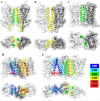Computational approaches for modeling GPCR dimerization
- PMID: 25307013
- PMCID: PMC4237661
- DOI: 10.2174/1389201015666141013102515
Computational approaches for modeling GPCR dimerization
Abstract
Growing experimental evidences suggest that dimerization and oligomerization are important for G Protein- Coupled Receptors (GPCRs) function. The detailed structural information of dimeric/oligomeric GPCRs would be very important to understand their function. Although it is encouraging that recently several experimental GPCR structures in oligomeric forms have appeared, experimental determination of GPCR structures in oligomeric forms is still a big challenge, especially in mimicking the membrane environment. Therefore, development of computational approaches to predict dimerization of GPCRs will be highly valuable. In this review, we summarize computational approaches that have been developed and used for modeling of GPCR dimerization. In addition, we introduce a novel two-dimensional Brownian Dynamics based protein docking approach, which we have recently adapted, for GPCR dimer prediction.
Figures





Similar articles
-
Oligomerization of G protein-coupled receptors: computational methods.Curr Med Chem. 2011;18(30):4588-605. doi: 10.2174/092986711797379320. Curr Med Chem. 2011. PMID: 21864281 Review.
-
Computational prediction of GPCR oligomerization.Curr Opin Struct Biol. 2019 Apr;55:178-184. doi: 10.1016/j.sbi.2019.04.005. Epub 2019 Jun 4. Curr Opin Struct Biol. 2019. PMID: 31170578 Review.
-
Prediction and targeting of GPCR oligomer interfaces.Prog Mol Biol Transl Sci. 2020;169:105-149. doi: 10.1016/bs.pmbts.2019.11.007. Epub 2020 Jan 6. Prog Mol Biol Transl Sci. 2020. PMID: 31952684 Review.
-
Bioinformatics and molecular modelling approaches to GPCR oligomerization.Curr Opin Pharmacol. 2010 Feb;10(1):30-7. doi: 10.1016/j.coph.2009.11.001. Epub 2009 Dec 16. Curr Opin Pharmacol. 2010. PMID: 20015686 Review.
-
The study of G-protein coupled receptor oligomerization with computational modeling and bioinformatics.FEBS J. 2005 Jun;272(12):2926-38. doi: 10.1111/j.1742-4658.2005.04730.x. FEBS J. 2005. PMID: 15955053 Review.
Cited by
-
Ghrelin Through GHSR1a and OX1R Heterodimers Reveals a Gαs-cAMP-cAMP Response Element Binding Protein Signaling Pathway in Vitro.Front Mol Neurosci. 2018 Jul 17;11:245. doi: 10.3389/fnmol.2018.00245. eCollection 2018. Front Mol Neurosci. 2018. PMID: 30065627 Free PMC article.
-
Apelin receptor homodimer-oligomers revealed by single-molecule imaging and novel G protein-dependent signaling.Sci Rep. 2017 Jan 16;7:40335. doi: 10.1038/srep40335. Sci Rep. 2017. PMID: 28091541 Free PMC article.
-
Integration and Spatial Organization of Signaling by G Protein-Coupled Receptor Homo- and Heterodimers.Biomolecules. 2021 Dec 3;11(12):1828. doi: 10.3390/biom11121828. Biomolecules. 2021. PMID: 34944469 Free PMC article. Review.
-
Methods used to study the oligomeric structure of G-protein-coupled receptors.Biosci Rep. 2017 Apr 20;37(2):BSR20160547. doi: 10.1042/BSR20160547. Print 2017 Apr 30. Biosci Rep. 2017. PMID: 28062602 Free PMC article. Review.
-
Mapping the Interface of a GPCR Dimer: A Structural Model of the A2A Adenosine and D2 Dopamine Receptor Heteromer.Front Pharmacol. 2018 Aug 30;9:829. doi: 10.3389/fphar.2018.00829. eCollection 2018. Front Pharmacol. 2018. PMID: 30214407 Free PMC article.
References
-
- Ellis C. The state of GPCR research in 2004. Nat. Rev. Drug Discov. 2004;3(7):575, 577–575, 626. - PubMed
-
- Muller G. Towards 3D structures of G protein-coupled receptors: a multidisciplinary approach. Curr. Med. Chem. 2000;7(9):861–888. - PubMed
-
- Pin JP, Neubig R, Bouvier M, Devi L, Filizola M, Javitch JA, Lohse MJ, Milligan G, Palczewski K, Parmentier M, Spedding M. International Union of Basic and Clinical Pharmacology. LXVII. Recommendations for the recognition and nomenclature of G protein-coupled receptor heteromultimers. Pharmacol. Rev. 2007;59(1):5–13. - PubMed
-
- Filizola M. Advances in Experimental Medicine and Biology: G Protein-Coupled Receptors - Modeling and Simulation, Part II GPCRs in Motion: Insights from Simulations. 2014;796:37–125.
Publication types
MeSH terms
Substances
Grants and funding
LinkOut - more resources
Full Text Sources
Other Literature Sources

